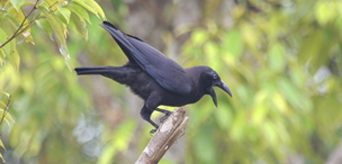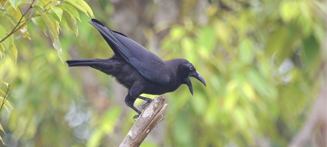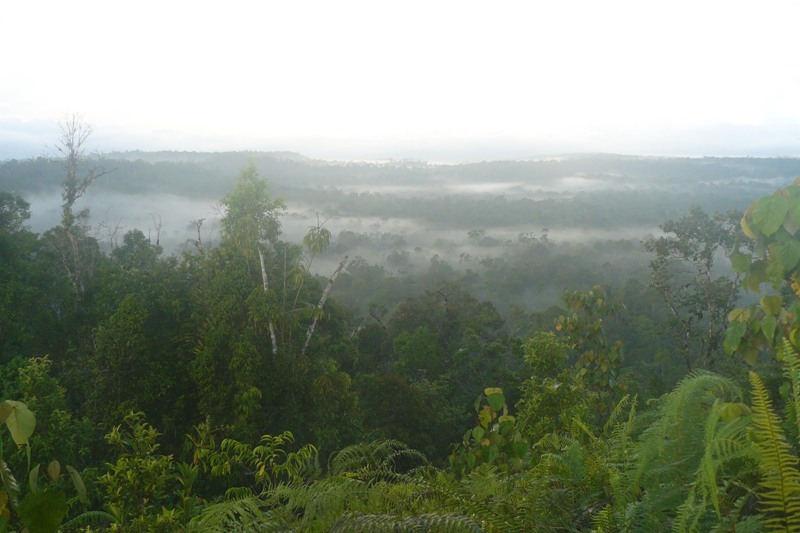Birding on Peleng & Banggai
Summary:
A nice selection of Sula endemics after a short boat ride from Luwuk, including the newly rediscovered Banggai Crow.
Key bird species:
Sula Scrubfowl, Ornate Lorikeet, Great-billed Kingfisher (Endemic ssp), Ivory-backed Woodswallow, Grosbeak Starling, Banggai Fruit-Dove, Sula Hanging-Parrot,Moluccan King Parrot, Banggai [Moluccan] Scops-Owl, Ruddy Kingfisher (Endemic ssp), Red-bellied [Sula] Pitta, Slaty Cuckooshrike, Northern Golden Bulbul, Banggai Crow, Red-and-Black Thrush, ‘Peleng Leaf-Warbler’, Henna-tailed Jungle-Flycatcher, Rusty-bellied Fantail, Drab Whistler, Helmeted Myna
Birdwatching locations:
The Banggai Archipelago lies off the eastern side of Sulawesi and is dominated by the large island of Peleng, and the smaller island of Banggai. The islands are very interesting for birding, sharing characteristics with both Sulawesi and the Sula Islands to the east, as well as holding its own specialities such as Banggai Crow.
Birding these island means making your own way around and doing some exploring. A couple of sites are known quite well, but there are definitely more interesting places still to be found. Around Salakan Around the capital ‘city’ of Salakan are extensive areas of degraded lowland forest, interspersed with agriculture. Access to these forest areas is possible from the main roads north and south of town. Just look for anywhere interesting and dive in. One area that has been visited several times lies around 10km north, near the village of Kawalu where basic accommodation can also be arranged by the Village Head. Birds seen in this area have included Sula Scrubfowl, Ornate Lorikeet, Ivory-backed Woodswallow, Grosbeak Starling, Banggai Fruit-Dove, Sula Hanging-Parrot, Banggai [Moluccan] Scops-Owl, Ruddy Kingfisher, Red-bellied [Sula] Pitta, Red-and-Black Thrush, Henna-tailed Jungle-Flycatcher and Helmeted Myna Tataba and Kokolomboi To get to good condition hill and sub-montane forest you will have to travel to the west of the island, where the village of Tataba makes a good base. Walking inland (up!) from here takes you to the small village of Kokolomboi after around four hours walk. The trail passes from coastal agriculture through degraded mosaic forest, to intact forest on the hills and ridges. Birding can be productiuve along the whole route, but is excellent in the hill forest near the top. Birds seen here include Ornate Lorikeet, Ivory-backed Woodswallow, Banggai Fruit-Dove, Sula Hanging-Parrot, Moluccan King Parrot, Banggai [Moluccan] Scops-Owl, Red-bellied [Sula] Pitta, Slaty Cuckooshrike, Northern Golden Bulbul, Banggai Crow, Red-and-Black Thrush, ‘Peleng Leaf-Warbler’, Henna-tailed Jungle-Flycatcher, Rusty-bellied Fantail, Drab Whistler and Helmeted Myna Elsewhere on Peleng Further exploration of the South-West of South-east of the island could be rewarding. The coastal strip will usually be degraded, but venturing inland on foot will almost always access better habitat. Banggai The island that gave its name to the archipelago, and in turn the crow, generally receives far less attention from birders than its larger neighbour Peleng. However, it would still make for an interesting visit, rewarded with many of the same birds as Peleng and who knows what else…Access and Accommodation:
Getting to Peleng is relatively straightforward from the Sulawesi town of Luwuk; now served by regular daily flights from Makassar (Merpati, Lion). From Luwuk you will then need to get to the port and try and catch a ferry to Peleng. These go most regularly overnight to Salakan, but some morning boats go direct to Tataba (but not every day it seems).
A road follows the coast on Peleng, so it is possible to drive, bus or motorbike your way between Salakan and Tataba (and beyond, if you desire). The birding sites around Salakan can also be reached by vehicle (a motorbike, most easily). To reach Kokolomboi from Tataba requires walking for a few hours. For accommodation there are plenty of places in Luwuk (check a book like Lonely Planet). There are also simple hotels in Salakan. Outside of these places, including Kokolomboi and Kawalu) you should be reporting to the Village Head (Kepala Desa) and so can then ask for assistance in finding somewhere to stay. At time of writing Pak Maleso in Kokolomboi is able to assist birders visiting the village, and he can maybe be contacted by email at is ayubmaleso@yahoo.co.id. Another local, Pak Labi, can also assist those arriving in Tataba, and can be contacted (at time of writing) on +6281245450834.More info:
Scroll down the page for related information, including photos, comments, trip reports, guides and services, articles and news. . If you can update this account, or find things have changed, please add your comments below to make it easier for the next person. Thanks!
Site map:
To download the kml file click here




¤ Feb. 2020 ¤
Looking for local conservation projects, or even foreigners passing through for birding – to join forces, birdwatch and/or to volunteer.
I’ll be returning to Sulawesi for the first time in 8 years, and wanted to reach out in case anyone will be in Banggai or Peleng in February 2020.
Adam (born 1986), professional sailor, experienced trekker and European bird-ringer with some command of Malay/Indonesian – having lived in Malaysia in his teens.
A flexible traveler – feel free to contact me.
¤ ¤
hello adam.i’m azman from malaysia. i’m looking for peleng local bird guide and interested birding in peleng .how do i contact you